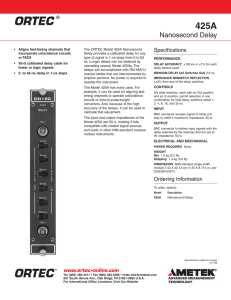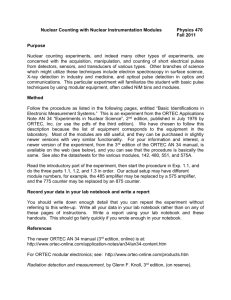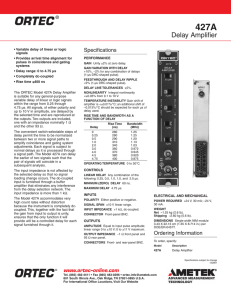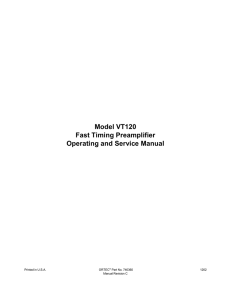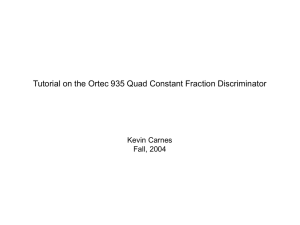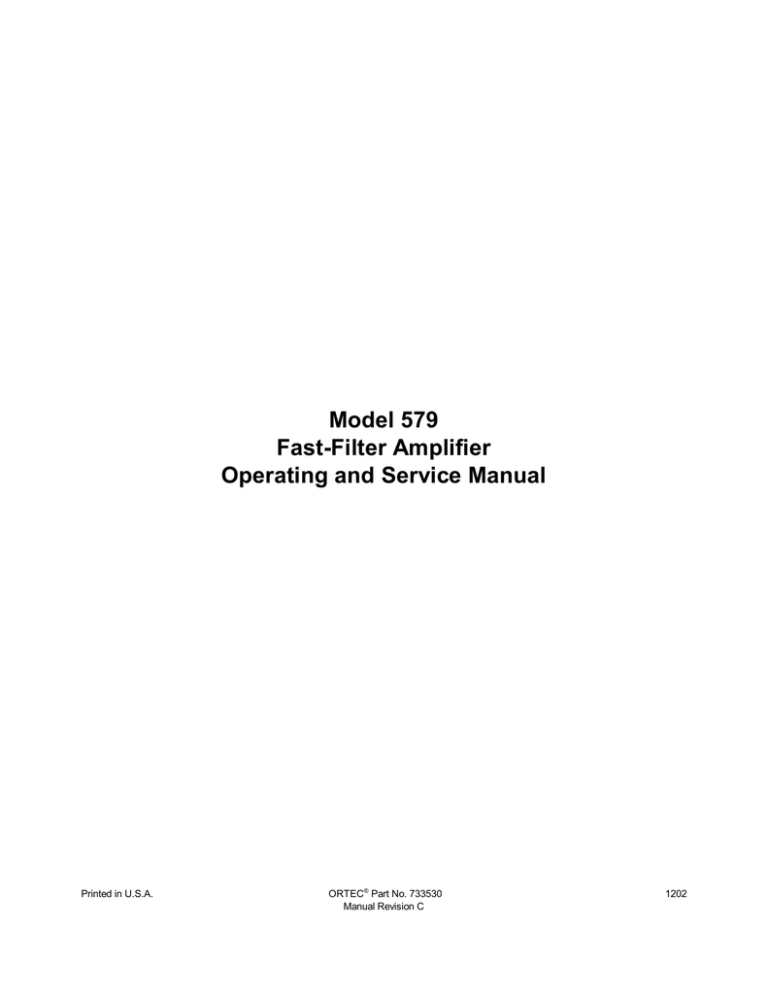
Model 579
Fast-Filter Amplifier
Operating and Service Manual
Printed in U.S.A.
ORTEC® Part No. 733530
Manual Revision C
1202
Advanced Measurement Technology, Inc.
a/k/a/ ORTEC®, a subsidiary of AMETEK®, Inc.
WARRANTY
ORTEC* warrants that the items will be delivered free from defects in material or workmanship. ORTEC makes
no other warranties, express or implied, and specifically NO WARRANTY OF MERCHANTABILITY OR
FITNESS FOR A PARTICULAR PURPOSE.
ORTEC’s exclusive liability is limited to repairing or replacing at ORTEC’s option, items found by ORTEC to
be defective in workmanship or materials within one year from the date of delivery. ORTEC’s liability on any
claim of any kind, including negligence, loss, or damages arising out of, connected with, or from the performance
or breach thereof, or from the manufacture, sale, delivery, resale, repair, or use of any item or services covered
by this agreement or purchase order, shall in no case exceed the price allocable to the item or service furnished
or any part thereof that gives rise to the claim. In the event ORTEC fails to manufacture or deliver items called
for in this agreement or purchase order, ORTEC’s exclusive liability and buyer’s exclusive remedy shall be release
of the buyer from the obligation to pay the purchase price. In no event shall ORTEC be liable for special or
consequential damages.
Quality Control
Before being approved for shipment, each ORTEC instrument must pass a stringent set of quality control tests
designed to expose any flaws in materials or workmanship. Permanent records of these tests are maintained for
use in warranty repair and as a source of statistical information for design improvements.
Repair Service
If it becomes necessary to return this instrument for repair, it is essential that Customer Services be contacted in
advance of its return so that a Return Authorization Number can be assigned to the unit. Also, ORTEC must be
informed, either in writing, by telephone [(865) 482-4411] or by facsimile transmission [(865) 483-2133], of the
nature of the fault of the instrument being returned and of the model, serial, and revision ("Rev" on rear panel)
numbers. Failure to do so may cause unnecessary delays in getting the unit repaired. The ORTEC standard
procedure requires that instruments returned for repair pass the same quality control tests that are used for
new-production instruments. Instruments that are returned should be packed so that they will withstand normal
transit handling and must be shipped PREPAID via Air Parcel Post or United Parcel Service to the designated
ORTEC repair center. The address label and the package should include the Return Authorization Number
assigned. Instruments being returned that are damaged in transit due to inadequate packing will be repaired at the
sender's expense, and it will be the sender's responsibility to make claim with the shipper. Instruments not in
warranty should follow the same procedure and ORTEC will provide a quotation.
Damage in Transit
Shipments should be examined immediately upon receipt for evidence of external or concealed damage. The carrier
making delivery should be notified immediately of any such damage, since the carrier is normally liable for damage
in shipment. Packing materials, waybills, and other such documentation should be preserved in order to establish
claims. After such notification to the carrier, please notify ORTEC of the circumstances so that assistance can be
provided in making damage claims and in providing replacement equipment, if necessary.
Copyright © 2002, Advanced Measurement Technology, Inc. All rights reserved.
*ORTEC® is a registered trademark of Advanced Measurement Technology, Inc. All other trademarks used
herein are the property of their respective owners.
iii
CONTENTS
WARRANTY . . . . . . . . . . . . . . . . . . . . . . . . . . . . . . . . . . . . . . . . . . . . . . . . . . . . . . . . . . . . . . . . . . . . . . . ii
SAFETY INSTRUCTIONS AND SYMBOLS . . . . . . . . . . . . . . . . . . . . . . . . . . . . . . . . . . . . . . . . . . . . . . . iv
SAFETY WARNINGS AND CLEANING INSTRUCTIONS . . . . . . . . . . . . . . . . . . . . . . . . . . . . . . . . . . . . . v
1. DESCRIPTION . . . . . . . . . . . . . . . . . . . . . . . . . . . . . . . . . . . . . . . . . . . . . . . . . . . . . . . . . . . . . . . . . . . 1
2. SPECIFICATIONS . . . . . . . . . . . . . . . . . . . . . . . . . . . . . . . . . . . . . . . . . . . . . . . . . . . . . . . . . . . . . . . .
2.1. PERFORMANCE . . . . . . . . . . . . . . . . . . . . . . . . . . . . . . . . . . . . . . . . . . . . . . . . . . . . . . . . . . .
2.2. CONTROLS AND INDICATOR . . . . . . . . . . . . . . . . . . . . . . . . . . . . . . . . . . . . . . . . . . . . . . . . .
2.3. INPUTS . . . . . . . . . . . . . . . . . . . . . . . . . . . . . . . . . . . . . . . . . . . . . . . . . . . . . . . . . . . . . . . . . .
2.4. OUTPUTS . . . . . . . . . . . . . . . . . . . . . . . . . . . . . . . . . . . . . . . . . . . . . . . . . . . . . . . . . . . . . . . .
2.5. ELECTRICAL AND MECHANICAL . . . . . . . . . . . . . . . . . . . . . . . . . . . . . . . . . . . . . . . . . . . . . .
5
5
5
5
6
6
3. INSTALLATION . . . . . . . . . . . . . . . . . . . . . . . . . . . . . . . . . . . . . . . . . . . . . . . . . . . . . . . . . . . . . . . . . .
3.1. GENERAL . . . . . . . . . . . . . . . . . . . . . . . . . . . . . . . . . . . . . . . . . . . . . . . . . . . . . . . . . . . . . . . .
3.2. CONNECTION TO POWER . . . . . . . . . . . . . . . . . . . . . . . . . . . . . . . . . . . . . . . . . . . . . . . . . . .
3.3. INPUT/OUTPUT CONNECTIONS . . . . . . . . . . . . . . . . . . . . . . . . . . . . . . . . . . . . . . . . . . . . . .
6
6
6
6
4. OPERATING INSTRUCTIONS . . . . . . . . . . . . . . . . . . . . . . . . . . . . . . . . . . . . . . . . . . . . . . . . . . . . . . . 7
5. MAINTENANCE . . . . . . . . . . . . . . . . . . . . . . . . . . . . . . . . . . . . . . . . . . . . . . . . . . . . . . . . . . . . . . . . . . 8
5.1. CORRECTIVE MAINTENANCE . . . . . . . . . . . . . . . . . . . . . . . . . . . . . . . . . . . . . . . . . . . . . . . . 8
5.2. FACTORY SERVICE . . . . . . . . . . . . . . . . . . . . . . . . . . . . . . . . . . . . . . . . . . . . . . . . . . . . . . . . 8
iv
SAFETY INSTRUCTIONS AND SYMBOLS
This manual contains up to three levels of safety instructions that must be observed in order to avoid
personal injury and/or damage to equipment or other property. These are:
DANGER
Indicates a hazard that could result in death or serious bodily harm if the safety instruction
is not observed.
WARNING
Indicates a hazard that could result in bodily harm if the safety instruction is not observed.
CAUTION
Indicates a hazard that could result in property damage if the safety instruction is not
observed.
Please read all safety instructions carefully and make sure you understand them fully before attempting to
use this product.
In addition, the following symbol may appear on the product:
ATTENTION–Refer to Manual
DANGER–High Voltage
Please read all safety instructions carefully and make sure you understand them fully before attempting to
use this product.
v
SAFETY WARNINGS AND CLEANING INSTRUCTIONS
DANGER
Opening the cover of this instrument is likely to expose dangerous voltages. Disconnect the
instrument from all voltage sources while it is being opened.
WARNING Using this instrument in a manner not specified by the manufacturer may impair the
protection provided by the instrument.
Cleaning Instructions
To clean the instrument exterior:
! Unplug the instrument from the ac power supply.
! Remove loose dust on the outside of the instrument with a lint-free cloth.
! Remove remaining dirt with a lint-free cloth dampened in a general-purpose detergent and water
solution. Do not use abrasive cleaners.
CAUTION To prevent moisture inside of the instrument during external cleaning, use only enough liquid
to dampen the cloth or applicator.
!
Allow the instrument to dry completely before reconnecting it to the power source.
vi
1
ORTEC MODEL 579
FAST-FILTER AMPLIFIER
1. DESCRIPTION
The ORTEC Model 579 wideband Fast-Filter
Amplifier with Gated Baseline Restorer is a state-ofthe-art hybrid-circuit instrument (Fig. 1.1). It is
designed to enhance fast-timing measurements by
improving the slope-to-noise ratio and providing
ultra-high count rate spectroscopy capability.
and Table 1). Excellent dc and gain stability
(±50 V/°C and ±0.05%/°C respectively) eliminates
the need for a dc-level adjustment (Figs. 1.5 and
1.6), and, to further improve the human interface, a
Busy LED and Busy Output are included to aid in
BLR adjustment and system interfacing.
The experimenter will recognize ORTEC's firm
commitment to fulfill the most demanding
experimental needs with quality instrumentation.
Fast (5 ns) rise time (Fig. 1.2), high output drive
(±5 V into 50 ), and wide voltage gain range (X0.9
- X500) make the 579 useful for many timing
applications, including those utilizing low-gain
photomultiplier tubes. The 579 is particularly suited
for use with ORTEC Constant Fraction
Discriminators such as the 583,584,934, or 473A in
timing applications with High-Purity Germanium
(HPGe) or Surface Barrier Detectors (Figs. 1.3, 1.4,
In addition, the wideband gated baseline restorer
and pole-zero cancellation network permit ultra-high
output counting rates (Fig. 1.7). A wide variety of
pulse filtering is available for improved signal
processing. The 579 combines continuously,
variable gain, independently selectable integration
and differentiation time constants (Figs. 1.8 and
1.9), and cable clipping capability (external cable
delay), making this versatile unit an important asset
for advanced time and energy spectroscopy.
S
:
Fig. 1.1. Block Diagram of the 579 Fast-Filter Amplifier.
2
Fig. 1.2. 579 Output Signals for Ji = JD = Out at 1, 2.5, and
5V.
Fig. 1.3. Gamma-Gamma Coincidence System Using a Plastic Scintillator and a Large HPGe Coaxial
Detector.
3
4
5
2. SPECIFICATIONS
2.1. PERFORMANCE
INPUT SIGNAL AMPLITUDE RANGE ±1.0 V ac,
±5.0 V ac with X5 internal Attenuator; ±35 V dc;
input impedance 100 ; 50 optional.
S S
DIFF
Front panel 7-position switch selects a
differentiation time constant to control the decay
time of the pulse. Decay time 2.2 D with i = Out.
The D settings include Out, 10, 20, 50, 100, 200,
and 500 ns.
/ J
J
J
RISE TIME <5 ns with Integrate and Differentiate
Out, or .2.2 i for other integrate settings and
Differentiate Out.
INT Front panel 7-position switch selects an
integration time constant to control the rise time of
the output pulse. The rise time is 2.2 i with D =
Out. The i settings include Out, 10, 20, 50,100,
200, and 500 ns. Rise time in the Out position is <5
ns, equivalent to a i <2.3 ns.
OVERSHOOT Typically 10% with Integrate Out, or
<2% for any selected integration.
INV/NONINV Front panel locking toggle switch
selects inversion or noninversion of the input signal.
NOISE For maximum gain, rms noise referred to
the input is <10 V (typically 5 V), with i = D) =
200 ns, measured with an HP3400A true rms
voltmeter. Wideband (200 MHZ) noise for i = D =
Out is <50 V (typically 40 V).
BLR ADJ Front panel screwdriver adjustment to set
the Gated BLR threshold from ±50 mV to ±500 mV
referred to the output.
OUTPUT AMPLITUDE RANGE 0 to ±5 V linear
into a 50 load.
S
J
:
:
:
J J
J J
:
INTEGRAL NONLINEARITY <1% (typically 0.5%)
over ±5 V range into 50 load.
S
TEMPERATURE INSTABILITY
DC level <±50
:V/°C referred to the output. DC level factory-set to
±5 mV. Gain instability <0.05%/°C (Figs. 1.5 and
1.6).
OPERATING TEMPERATURE RANGE
50°C (273 to 323 K).
0°C to
2.2. CONTROLS AND INDICATOR
COARSE GAIN Front panel 6-position switch to
select X15, X25, X50, X125, X250, and X500 gain
factor. When internal X5 Attenuator is used, the
coarse gain factors represent X3, X5, X10, X25,
X50, and X100 respectively. A continuously variable
voltage gain of X0.9 to X500 can be obtained. (Gain
reduced by factor of two when cable clip is used.)
FINE GAIN Front panel single-turn potentiometer,
continuously adjustable from 0.3 to 1.0.
P/Z Front panel screwdriver adjustable
potentiometer to adjust pole-zero cancellation for
decay time constants from 25 s to 4.
:
/
J
J
J
J
BLR GATED/UNGATED PCB jumper select for
gated or ungated BLR operation. Factory-set in
gated position.
BLR LED This feature enables the user to quickly
adjust the BLR threshold setting near the noise
peak. Front panel LED indicates an output
amplitude has exceeded the BLR threshold. The
BLR LED can be used as a visual indicator of the
output count rate.
COUNT RATE
High/Low PCB jumper selects minimum BLR
deadtime of typically 400 ns in high position and
typically 1 s in low position. Factory-set in low
position.
:
ATTENUATOR PCB jumper select to pass with
unity Gain or Attenuate by a factor of 5. Jumper
select B to C and A to F will pass with unity Gain.
Jumper select C to D and E to F will attenuate by a
factor of 5. Factory-set at unity Gain.
2.3. INPUTS
INPUT Front panel BNC accepts input signals of
either polarity, ±1.0 V ac or ±5.0 V ac with X5
6
Attenuator. Maximum dc voltage ±35 V. Input
impedance 100 (to match preamplifiers); 50
optional.
S
S
CLIP Two front panel BNC connectors to provide
delay line clipping of the input pulse. Cable
impedance must be 50 . Delay line clip is 2X the
cable propagation delay. Gain is reduced by factor
of 2 when using cable clip.
S
2.4. OUTPUTS
OUTPUT Front panel BNC connector furnishes
the amplified and shaped signal through Zout, <l .
Amplitude 0 to ±5V into 50 ; risetime and decay
time constants controlled by the integrate and
differentiate filter settings.
S
S
BUSY Rear panel BNC furnishes NIM-standard
positive logic signal during the BLR busy time.
PREAMP POWER Rear panel standard ORTEC
power connector, Amphenol 17-80090-15.
2.5. ELECTRICAL AND MECHANICAL
POWER REQUIRED +24V, 80 mA; -24V, 80mA;
+12V, 160 mA; -12 V, 140 mA. NIM-standard
single-width module.
WEIGHT
Net 1.5 kg (3.3 lb).
Shipping 3.0 kg (7.0 lb).
DIMENSIONS Standard single-width NIM module
(1.35 X 8.714 in.) per TID-20893 (Rev).
3. INSTALLATION
3.1. GENERAL
The ORTEC Model 579 operates on ±12 V and
±24V power that must be furnished from a nuclearstandard bin and power supply such as the ORTEC
4001C/4002Series. The bin and power supply is
designed for relay rack mounting. If the equipment
is to be rack mounted, be sure that there is
adequate ventilation to prevent any localized
heating of the components that are used in the 579.
The temperature of the equipment mounted in
racks can easily exceed the maximum limit of 50°C
(323 K) unless precautions are taken.
3.2. CONNECTION TO POWER
The 579 contains no internal power supply and
must obtain the necessary dc operating power from
the bin and power supply in which it is installed for
operation. Always turn off power for the power
supply before inserting or removing any modules.
ORTEC modules are designed so that a full
complement of modules installed in the bin will not
overload the NIM-standard power supply. Since,
however, this may not be true when the bin contains
modules other than those of ORTEC design, the dc
power levels should be checked after all of the
modules have been installed. The ORTEC bins and
power supplies have convenient test points on the
power supply control panel to permit monitoring
these dc levels.
3.3. INPUT/OUTPUT CONNECTIONS
S
The input impedance of the 579 is 100 and
provides a suitable termination for cable with a
characteristic impedance of 93 . If the cable that
is used for the input signals has a characteristic
impedance of 50 , use a BNC Tee at the 579 Input
to accommodate the cable and a 100 terminator;
the terminator and the input impedance, which are
cable
in parallel, will then match the 50
impedance.
S
S
S
S
The low output impedance of the 579 requires that
the output cable be terminated by the characteristic
impedance of the cable at its remote end. This can
be accomplished at the input of a high-input
impedance instrument or by using an instrument
with an input impedance equal to the impedance of
the cable.
7
4. OPERATING INSTRUCTIONS
Two principal functions may be furnished by the
ORTEC Model 579 wideband Fast-Filter Amplifier,
depending on the details of the system in which it is
installed. The 579 may be used to linearly amplify
a small amplitude range into one that is better
suited to the requirements of a subsequent
instrument in the system; the gain can be set at any
level from X0.9 to X500 for this purpose. The
shaping time constants that select integration and
differentiation circuits in the 579 can be set to
normalize a pulse rise and decay time to optimize
timing measurements. In addition to these basic
functions, the 579 can also be used to invert the
pulse polarity if desired and to correct for the polezero effect from the preamplifier in the system.
There are no typical control settings that can be
suggested for operation, since each application of
the 579 will require a different combination of
functions. After the system has been installed, use
an oscilloscope to observe the waveforms at the
input and output of the 579 and adjust its controls to
optimize its operation, considering the functions
that are required of it.
Generally speaking, the Integrate time constant can
be selected so that the rise time of the output
pulses is normalized at a rate that is slower than the
rise times of the input pulses. This function is of
greatest value when the pulses originate in a large
detector so that they generate a wide variety of rise
times and are difficult to observe for timing
measurements. The Differentiate time constant is
also selectable and determines the total interval
before the pulse returns to the baseline and allows
a new pulse to be observed. The combination of
integration and differentiation time constants also
contributes to the amount of electronic noise that is
seen in the system, so the resulting waveforms
should be considered from each of these points of
view and adjusted for best results.
Care must be used to determine the best BLR
threshold. The Busy LED on the front panel and
Busy Output on the rear panel facilitate adjustment.
The best way to adjust the BLR threshold is to first
select the desired gain and filter settings and adjust
the P/Z (pole-zero) with the detector connected to
the 579 input. Next, remove or block the radiation
source so that only background radiation strikes the
detector. Lower the BLR threshold by turning the
potentiometer counterclockwise until the BLR LED
begins to flicker.
A more accurate BLR threshold adjustment can be
made by connecting the 579 Busy Output to a
counter/timer, such as the ORTEC Model 871, and
adjusting the BLR threshold for approximately 200
cps at the Busy Output. The Busy Output indicates
the time when the output signal is not being
sampled by the gated baseline restorer.
If the BLR threshold is too low, there is a possibility
of excessive noise on the baseline and a baseline
shift at low counting rates. When the BLR threshold
is set too high, a premature baseline shift will occur
as count rate increases. These comments are
generally true for any instrument having a gated
baseline restorer.
8
5. MAINTENANCE
5.1. CORRECTIVE MAINTENANCE
5.2. FACTORY SERVICE
The ORTEC Model 579 should require no regular
maintenance other than replacement of
components that have failed due to age. Always
ensure that the replacement components are
equivalent to the original parts. No internal
trimming or adjustment is necessary for the 579.
This instrument can be returned to the ORTEC
factory for service and repair at a nominal cost. The
ORTEC standard procedure for repair ensures the
same quality control and checkout that are used for
a new instrument. Always contact Customer
Services at ORTEC, (865) 483-2231, before
sending in an instrument for repair to obtain
shipping instructions and so that the required
Return Authorization Number can be assigned to
the unit. This number should be written on the
address label and on the package to ensure prompt
attention when it reaches the factory.
Bin/Module Connector Pin Assignments
For Standard Nuclear Instrument
Modules per DOE/ER-0457T.
Pin
1
2
3
4
5
6
7
8
9
*10
*11
12
13
14
15
*16
*17
18
19
20
21
22
Function
+3 V
-3V
Spare bus
Reserved bus
Coaxial
Coaxial
Coaxial
200 V dc
Spare
+6 V
-6V
Reserved bus
Spare
Spare
Reserved
+12 V
- 12 V
Spare bus
Reserved bus
Spare
Spare
Reserved
Pin
23
24
25
26
27
*28
*29
30
31
32
*33
*34
35
36
37
38
39
40
*41
*42
G
Function
Reserved
Reserved
Reserved
Spare
Spare
+24 V
- 24 V
Spare bus
Spare
Spare
117 V ac (hot)
Power return ground
Reset (Scaler)
Gate
Reset (Auxiliary)
Coaxial
Coaxial
Coaxial
117 V ac (neutral)
High-quality ground
Ground guide pin
Pins marked (*) are installed and wired in
ORTEC’s 4001A and 4001C Modular System
Bins.

